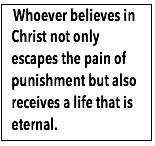|
As Moses lifted up the serpent in the wilderness,
so must the Son of man be lifted up, so that all who believe in him
may not perish but may have eternal life.
With the wonderful skill
he has in imparting heavenly teaching, the Lord of the
teachers of the Mosaic law shows us that law’s spiritual
meaning, as he recalls the old history and explains its
symbolic reference to his own passion and to our salvation.
The Book of Numbers relates that the Israelites, wearied by the long hard journey
in the wilderness, grumbled against the Lord and Moses, and therefore the Lord
sent fiery serpents among them.
Many died of their bites, and when the people
cried out to Moses and he prayed for them, the Lord commanded him to make a
bronze serpent and set it up as a sign.
“Those who are bitten,” he said, “have
but to look at it and they will live”; and so it happened.
 Now the bites of fiery serpents are the evil temptations to sin that bring
spiritual death to the soul deceived by them. It was good for the people who
grumbled against the Lord to be prostrated by the bites of serpents, for this
outward scourge would make them realize how much inward damage they suffered
because of their grumbling. Now the bites of fiery serpents are the evil temptations to sin that bring
spiritual death to the soul deceived by them. It was good for the people who
grumbled against the Lord to be prostrated by the bites of serpents, for this
outward scourge would make them realize how much inward damage they suffered
because of their grumbling.
The bronze serpent that was raised up so that those
who were bitten might look at it and be healed represents our Redeemer in his
passion on the cross, for the kingdom of death and sin is conquered only by
faith in him.
The sins which drag both soul and body to destruction are well described as
serpents, not only because they are fiery and poisonous and cunning enough
to destroy us, but because a serpent persuaded our first parents, who were
immortal, to commit the sin through which they became subject to death.
Our
Lord, who came in the likeness of sinful flesh, is rightly portrayed as the
bronze serpent because as the bronze serpent was the same as the fiery serpents
except that it contained no poisonous or hurtful fire, and when it was raised
up it healed those bitten by serpents, so also the Redeemer of humankind clothed
himself not in sinful flesh, but in the likeness of sinful flesh, in which,
by suffering death on the cross, he delivered those who believe in him from
all sin and even from death itself.
“Therefore as Moses lifted up the serpent in the wilderness, so must the Son
of man be lifted up”; for as those who looked at the bronze serpent set
up as a sign were for a time healed of the physical death and injury produced
by the serpents’ bites, so also those who look at the mystery of the Lord’s
passion, believing, confessing, and sincerely imitating him, are saved completely
and for ever from the death of both soul and body which they had incurred through
sin.
Accordingly the text continues: “so that all who believe in him may
not perish, but may have eternal life.” These words make it clear that whoever
believes in Christ not only escapes the pain of punishment but also receives
a life that is eternal.
And here we see the difference between symbol and truth,
for the one prolongs this temporal life, while the other gives a life that
will be endless.
We must make sure, however, that the truths our minds perceive
are given fitting practical expression, so that by confessing the true faith,
and living devout and disciplined lives, we may deserve to attain the fullness
of the life which has no end.
(Homily
11, 18: CCL CXXII, 31517)
Bede (c.
673-735), who received the title of Venerable less than a
century after his death, was placed
at the age of seven in the monastery of Wearniouth, then ruled
by Saint Better Biscop. From there he was sent to Jarrow, probably
at the time of its foundation in about 681. At the age of thirty
he was ordained priest. His whole life was devoted to the study
of Scripture, to teaching, writing, and the prayer of the Divine
Office. He was famous for his learning, although lie never
went beyond the bounds of his native Northumbria. Bede is best
known for his historical works, which earned him the title
“Father of English History.” His Historia
Ecelesiastica Gentis
Anglorum is a primary source for early English history,
especially valuable because of the care he took to give his
authorities,
and to separate historical fact from hearsay and tradition.
In 1899 Bede was proclaimed a doctor of the Church. |